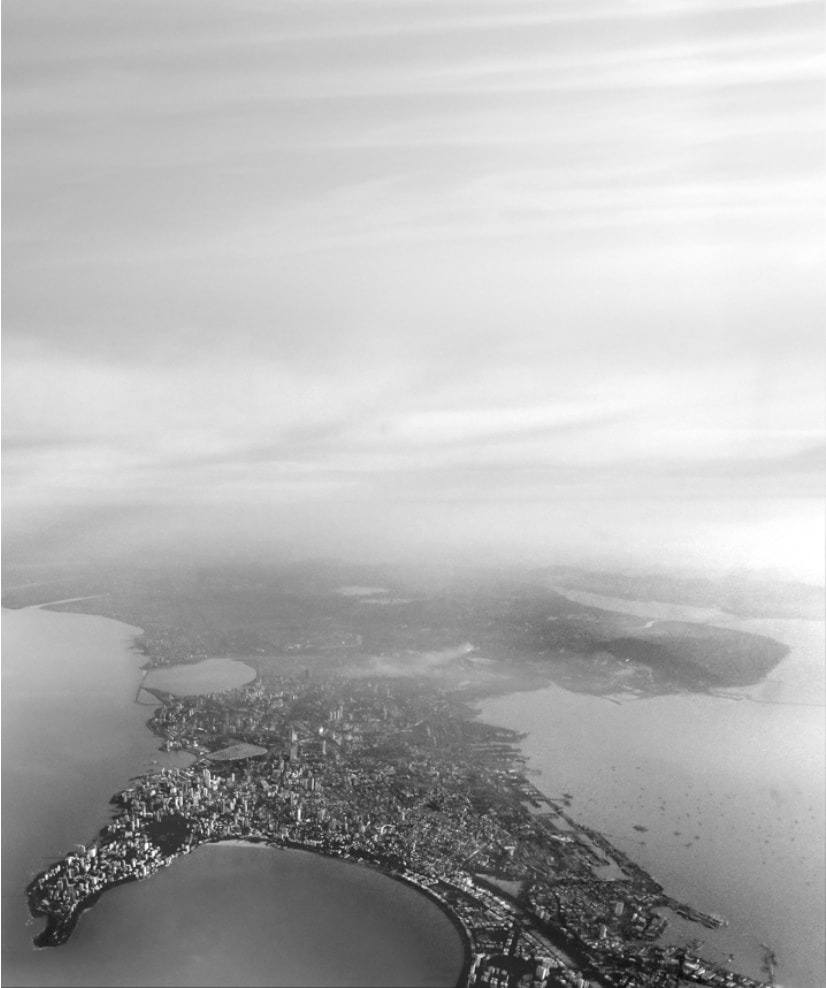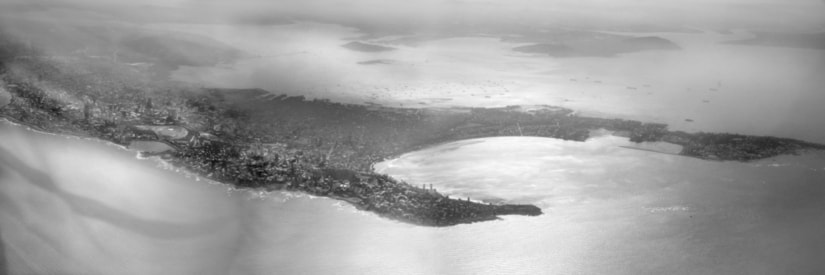Take a stroll down Marine Drive in Mumbai, and chances are you will come across people attempting to photograph the iconic sea front, framed by skyscrapers on one side and the setting sun on the other. Go to the Gateway of India and you will find tourists and visitors posing in front of the 20th-century edifice. Drive down the Bandra-Worli Sea Link, and frazzled passengers will attempt to capture the Mumbai skyline or the symmetric structure of the bridge. In all these instances, one finds individuals attempting to create a narrative of Mumbai, trying to establish themselves as part of the historic city through the images they take. For architect Robert D Stephens, his interest in the city’s history and heritage manifests in the aerial photographs he takes. Hailing from South Carolina in the US, Stephens has been residing in the city for the past 11 years. After a two-week long visit to Mumbai in 2006, when he explored the city, he found that he enjoyed it immensely and decided to settle down here the very next year. Apart from his tryst with the skies, Stephens is also a lover of art, history and books, and has been collecting rare books since 2007. Eleven years of photographing and collecting culminated in a delightful tactile exhibition of aerial photographs and rare Mumbai guidebooks (dated from 1880s and 1980s), at the ARTISANS’ Gallery in Mumbai in May. On top of the world Taken from flights while travelling for work, Stephens says his photographs are an expression of stepping back from the city. “Every day, we see the city at a very micro level. As much as I love the trains, it is still jam-packed, more than it should be for a city of this scale,” he says. [caption id=“attachment_4825551” align=“alignnone” width=“826”]  ‘Back Bay to Salsette’ by Robert D Stephens[/caption] He likens living in Mumbai to the difference between dating and marriage. “When you’re dating someone, you see them periodically. You see only the attractive side to them. But when you get married, you’re with them every day. You see the reality and realise everything is not perfect. So, living in Mumbai for an extended period of time is like that,” he feels. The first couple of years in Mumbai were like a “honeymoon”, after which the city began to grind on his nerves. That is when he put up his first exhibition in 2014, a series of black and white aerial photographs of the city, which he terms a “stepping back”. “That would have been seven years after I came to Mumbai. Stepping back is like retreating from a marriage where a couple goes and refreshes, and gets to know one another again. So this was like my retreat from the city — seeing the big picture,” he says. Stephen’s intention was to retreat from the grimy close-up that the city presents and view it from a macro perspective, thereby appreciating its beauty. “Amid the grinding climate we’re all in, bad infrastructure and bumper-to-bumper traffic, stepping back and trying to rediscover moments of beauty just refreshes the spirit and makes us not give up hope on urban centres,” he feels. One of his first photographs of Mumbai from 2013 is a black-and-white print of the city covered in swathes of mist, with Lego-like skyscrapers pricking their way through the clouds. The Bandra-Worli Sea Link can be seen in the foreground, with towering ghats flanking the background. There are several such stunning and mesmerising photographs which capture the concrete jungle that Mumbai is, while helping one acknowledge the beauty of this island city. [caption id=“attachment_4825491” align=“alignnone” width=“825”]  Robert D Stephen’s ‘Mumbai Mist’[/caption] How does he manage to do all this from a mere airplane window? “I know the flight paths. Depending on the final destination, I know how the plane will turn and go. I choose the seats accordingly. It took 11 years of experience and over a 1,000 flights to memorise all of it,” Stephens shares. Portrait of a metropolis There are several unique aspects to Stephens’ photography. He superimposes words of the past in images of the present, through their descriptions. They are snippets taken from a plethora of historic and rare books (some dating back to 1870s) that the architect has collected over the last decade. These range from RP Karkaria’s 1915 book The Charm of Bombay, Gazetteer of Bombay City and Island (1908) to the 1964 Development Plan for Greater Bombay. “Again, it is a way of stepping back from the city. It is literal, literary and historical. The intention is to see images of the past in the present. Different people see different things. The point is just to engage the mind in the visual and intellectual sense, and sometimes in an emotional sense,” Stephens explains. [caption id=“attachment_4825581” align=“alignnone” width=“825”]  ‘Bombay Island City’ by Robert D Stephens[/caption] During exhibitions, the books from where captions for the photographs are taken are kept on display as well. Visitors are free to pick up the book and peruse it at length. One can actually find wonderful and surprising nuggets of information in these books. For example, if one flipped to page 137 of the 1964 Development Plan for Greater Bombay report, one would find that the Bandra-Worli Sea Link was proposed as far back as 45 years ago, before it was thrown open for public use in 2009. The second interesting aspect of Stephens’ aerial photography work is that each image is accompanied by the pollution levels recorded on the day he shot it. The idea is to juxtapose the misery and magic of living in cities. Given that his photographs are a captivating and stellar expression of the city’s geography, one would assume he uses fancy, expensive equipment for this endeavour. Except, that he doesn’t. He uses a point-and-blink digital camera. “I keep it in my pocket. It is a little bigger than my phone. You can just take it out and shoot. I upgraded to a recent model of Sony on 35 mm,” he says, explaining the only reason he uses it, is convenience. “I don’t like the big, bulky cameras. It’s not me.” Flipping through the pages of history The 16 guidebooks, sourced from Flora Fountain, Chor Bazar and from some of the oldest booksellers in London, are a physical expression of how the city has changed (or not) through a period of 100 years. “It is a unique story that tells a lot about Mumbai’s history, about books and social history. So I decided to build that narrative and make it public,” he says. Together, the books portray the changing landscape — geographical and cultural —of the Urbs Prima in Indis (first city of India) through the late 19th to 20th century. [caption id=“attachment_4825511” align=“alignnone” width=“825”]  Facebook/@artisans.centre.9[/caption] But why did he choose to make it a tactile experience? “Because I’m a tactile learner. As a child, I found that when teachers would say something, I would remember perhaps 30-40 percent of it. But if I learnt something through models, actual explorations, through trial and error, knowledge stayed with me longer and sunk in more,” Stephens explains. He adds that in a digital world, where one physically touches a screen most of the day, it is important to have a contrast. However, letting people handle some of the fragile books (dating back to 1880s) could result in an accidental rip of the page, here and there. It is was a calculated risk but one Stephens was willing to take. “Books are meant to be used. I think it is important for people to touch, use and experience books rather than keep them as museum pieces which are static. They are meant to be dynamic,” he says. When asked about how the Bombay/Mumbai representation changes over time through these books, the amateur historian replies that it is an evolving thought. The first set of guidebooks are made for the “ambitious European”, Stephens says. “The ambitious European may not have been wealthy but would have had some form of financial stability. They are people who came to Bombay with expectations. They could afford big and expensive books,” he says, adding the books were beautiful works of art, handcrafted, with lots of research and information in them. The second set of books and pamphlets is from during World War II. “These guidebooks were written for what I call ‘the obedient soldier’. So, there were people who didn’t choose to come to Bombay, but were ordered to by their seniors and obediently they came,” he says. Post World War II, there were mostly paperbacks which catered to Indian residents. Stephens feels the books showcase how history impacts culture. “In seeing the collection together, you see the physical impact of history on culture through paperbacks, thin books, mass-produced books and the wide range of audience it addresses.” For those who missed the exhibition, the books and pamphlets can still be accessed at the Urban Design Research Institute Library at Kala Ghoda in Mumbai.
Robert D Stephens takes aerial photographs of Mumbai, with the intent to provide a macro view of the city and appreciate its beauty
Advertisement
End of Article


)
)
)
)
)
)
)
)
)



